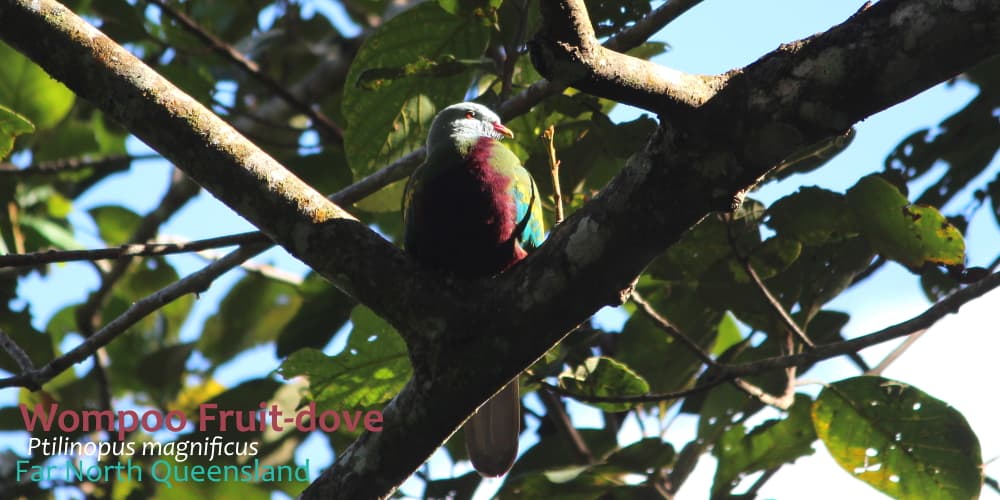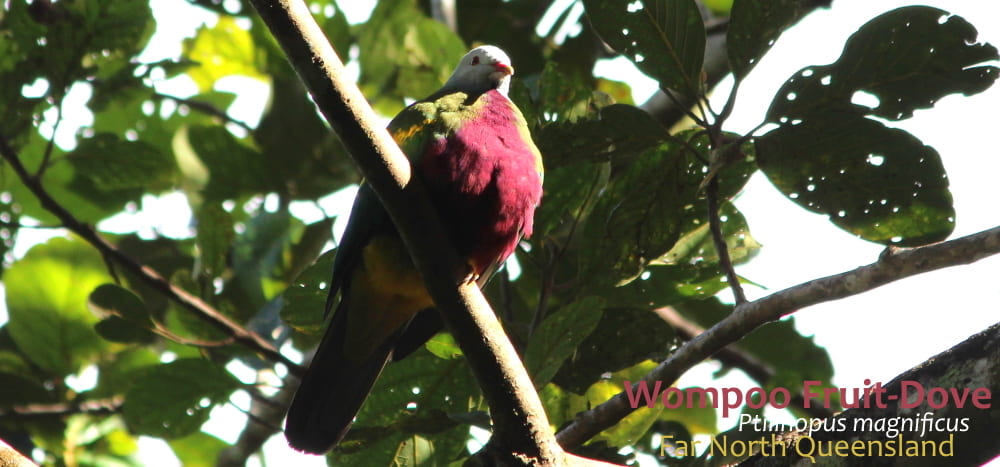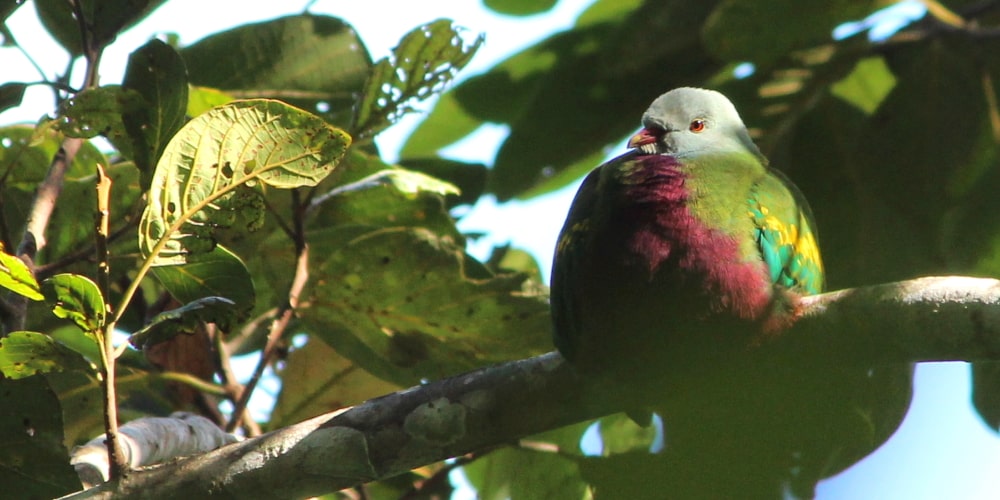High on a mossy branch, the bird watched me bumbling about on the rainforest track below.
The light in a far North Queensland tropical rainforest is both brilliant and muted. You walk in near darkness, peering into shadows, to be dazzled by a beam of pure white sunlight. The leafy canopy above is almost complete, only tiny gaps allow sunshine through.
Your eyes can’t decide whether to use rods or cones*.
I was looking for her. As a life-long admirer of all wild members of the pigeon and dove family, she was a prize that I didn’t want to leave far North Queensland without. But my eyes, too long accustomed to the open forests and big skies of western Victoria, didn’t work in this nighttime-daytime see-saw.
The birds of this place can be as multicoloured as a mardi gras, or as subtle as leaf litter, and it makes not a skerrick of difference. They are invisible unless they move or call.
Wompoo Fruit-doves have a surprising call. It is nasal, soft, almost a purr of pleasure. Listen:
She didn’t move or call. She was a rainforest pigeon, a creature coveted by humans for over 10,000 years – both for food and as a pet. They are amongst the most wary of wild birds.
I looked up, and finally, I saw her. My first Wompoo Fruit-dove Ptilinopus magnificus. She was watching me with her big red eyes. I was intoxicated.


..
She was every bit as glorious as I hoped. Her red-purplish breast was the colour of boysenberries – a colour rare in the rainforest, but hard to see. Her wings and back were every shade of green you can imagine, from olive to aqua to chartreuse. Along her wings and under her tail ran lines of bright sunshine yellow. Her head was the only subtle part of the plumage: pale blue-grey, to set off her red eye and red and gold bill.
Slowly she turned. I didn’t take my eyes off her, for fear of losing her. From behind, she was even harder to see – gold-edged green wings fading into grey and turquoise.

..
Wompoo Fruit-doves are large native rainforest pigeons that only live in north and east Queensland, northern New South Wales and New Guinea. There are three subspecies in Australia – the Cairns/Wet Tropics region birds are ssp keri. This subspecies is smaller than the NSW/south Qld spp magnificus, and the purple breast is maroon-purple.
To see them, you must be in rainforest, and it will help to have a local expert guide like James from FNQ Nature Tours. Don’t expect these doves to call, or flap around in big flocks. Listen for the sound of falling fruit – often that is the only sign they are present. As we’ve found with other rainforest pigeons, looking carefully for ripe fruit is sometimes the best way to find them.

..
This fruit dove is able to eat big rainforest fruits, such as Lilly Pillies Red Apple Acmena ingens (large, red) & Rose Satinash Syzygium francisii (large, purple); Black Muskheart Alangium villosum (large, black), Green Bollygum Neolitzea australiensis (large, purple), Incensewood Anthocarapa nitidula (large, brown), Native Tamarind Diploglottis australis (large, yellow & red), Yellow Tulipwood Drypetes deplanchei (large, red), and Pepper Vine Piper hederaceum (small but in large clusters, red).
Mary Clarke from Qld reports that they love to eat the Perfume Tree (Ylang Ylang) Cananga odorata – the fruits are 1.5 to 2.5cm diameter and black when ripe. She says: “I watch the fruit developing and know when I will have lots of Wompoos around.”
Medium sized fruit are also consumed: Laurels Crypotocarya triplinervis & bidwillii (both medium, black), Brown Beech Pennantia cunninghamii (medium, black), Myrtle Ebony Diospyros pentamera (medium, black), Buff Hazelwood Symplocos thwaitesii (medium, purple), Native Olive Olea paniculata (medium, blue-black), Native Figs Ficus macrophylla, platypoda, superba & watkinsiana (all medium, green to purple); Yellow Hollywood Vitex lignum-vitae (medium, red), White Cedar Melia azedarach (medium, yellow) and White Aspen / Yellow-wood Acronychia oblongifolia (medium, white).
Some small fruits are also eaten: Red Ash Alphitonia excelsa (small, black); Soft Water Vine Cayratia eurynema (small, purple) and Water Vines Cissus hypoglauca & antarctica (both small, purple but plentiful). [info from Forshaw, J – ref below]
..
Come with us and James from FNQ Nature Tours on our new Quolls & Birds in FNQ, see rainforest birds like the Wompoo Fruit-dove. We will take notes and photographs of whatever they are feeding on, to help contribute to knowledge of this magnificent bird. We will also be helping out with Tiger Quolls.
Here’s a gallery of pictures that do this dove more justice than mine.
..
NOTES & REFERENCES:
Read about the Wompoo Fruit Dove here: http://www.birdlife.org.au/bird-profile/wompoo-fruit-dove
Great information in Forshaw, Joseph “Pigeons and Doves in Australia” CSIRO Publishing 2015

